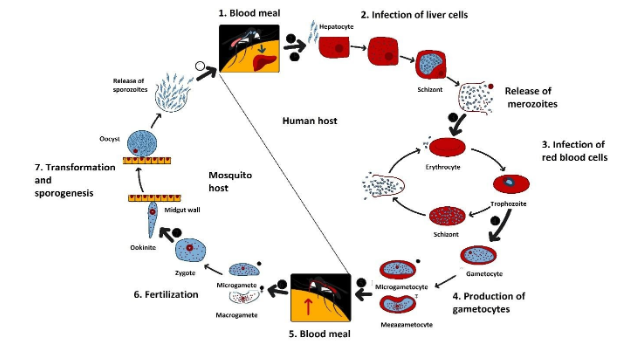
Write the name of the pathogen of typhoid. Explain the life cycle of malarial parasites with the help of a labelled diagram.
Answer
475.5k+ views
Hint: Malarial parasite is a protozoan. The life cycle includes two obligate parasites, one acting as a carrier and the other one as the host.
Complete step by step answer:
-The protozoan parasite which causes the disease malaria is a Plasmodium.
-Different types of malaria are caused by different species of Plasmodium.
-The most serious and fatal type of malaria is caused by Plasmodium falciparum.
-Malarial parasites require two hosts to complete its life cycle, those are the female Anopheles mosquito and human.
-The female Anopheles mosquito acts as a vector which transmits the disease to human beings.
The life cycle of the malarial parasite is as follows:
-When the female Anopheles mosquito bites a human, the sporozoites of the plasmodium enters the bloodstream of the person.
-The parasite first enters into the liver cells and multiplies within the liver cells.
-It then enters the bloodstream as merozoites.
-These attacks the RBC, which results in the rupture of RBC, along with the release of a toxic substance, called as hemozoin, which is responsible for the chill and high fever recurring every three to four days.
-When the female Anopheles mosquito bites an infected person, the parasite enters the mosquito body and undergoes further development in its body.
-These parasites develop into a sporozoite and are then stored in the salivary glands of the mosquito.

Note:
The sexual stage of the plasmodium occurs in the mosquito and the vegetative stage occurs in humans.
Complete step by step answer:
-The protozoan parasite which causes the disease malaria is a Plasmodium.
-Different types of malaria are caused by different species of Plasmodium.
-The most serious and fatal type of malaria is caused by Plasmodium falciparum.
-Malarial parasites require two hosts to complete its life cycle, those are the female Anopheles mosquito and human.
-The female Anopheles mosquito acts as a vector which transmits the disease to human beings.
The life cycle of the malarial parasite is as follows:
-When the female Anopheles mosquito bites a human, the sporozoites of the plasmodium enters the bloodstream of the person.
-The parasite first enters into the liver cells and multiplies within the liver cells.
-It then enters the bloodstream as merozoites.
-These attacks the RBC, which results in the rupture of RBC, along with the release of a toxic substance, called as hemozoin, which is responsible for the chill and high fever recurring every three to four days.
-When the female Anopheles mosquito bites an infected person, the parasite enters the mosquito body and undergoes further development in its body.
-These parasites develop into a sporozoite and are then stored in the salivary glands of the mosquito.

Note:
The sexual stage of the plasmodium occurs in the mosquito and the vegetative stage occurs in humans.
Recently Updated Pages
Using the following information to help you answer class 12 chemistry CBSE

Basicity of sulphurous acid and sulphuric acid are

Master Class 12 Economics: Engaging Questions & Answers for Success

Master Class 12 Maths: Engaging Questions & Answers for Success

Master Class 12 Biology: Engaging Questions & Answers for Success

Master Class 12 Physics: Engaging Questions & Answers for Success

Trending doubts
Which are the Top 10 Largest Countries of the World?

Differentiate between homogeneous and heterogeneous class 12 chemistry CBSE

Draw a labelled sketch of the human eye class 12 physics CBSE

What is the Full Form of PVC, PET, HDPE, LDPE, PP and PS ?

What is a transformer Explain the principle construction class 12 physics CBSE

What are the major means of transport Explain each class 12 social science CBSE




